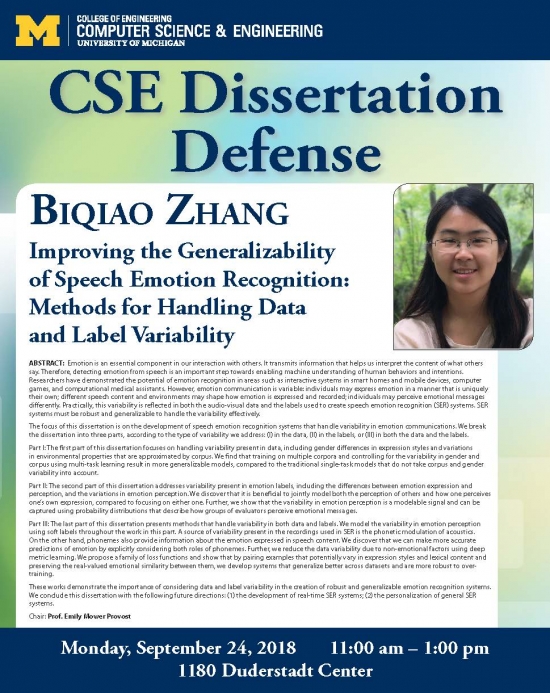Dissertation Defense
Improving the Generalizability of Speech Emotion Recognition: Methods for Handling Data and Label Variability
Add to Google Calendar

Emotion is an essential component in our interaction with others. It transmits information that helps us interpret the content of what others say. Therefore, detecting emotion from speech is an important step towards enabling machine understanding of human behaviors and intentions. Researchers have demonstrated the potential of emotion recognition in areas such as interactive systems in smart homes and mobile devices, computer games, and computational medical assistants. However, emotion communication is variable: individuals may express emotion in a manner that is uniquely their own; different speech content and environments may shape how emotion is expressed and recorded; individuals may perceive emotional messages differently. Practically, this variability is reflected in both the audio-visual data and the labels used to create speech emotion recognition (SER) systems. SER systems must be robust and generalizable to handle the variability effectively.
The focus of this dissertation is on the development of speech emotion recognition systems that handle variability in emotion communications. We break the dissertation into three parts, according to the type of variability we address: (I) in the data, (II) in the labels, or (III) in both the data and the labels.
Part I: The first part of this dissertation focuses on handling variability present in data, including gender differences in expression styles and variations in environmental properties that are approximated by corpus. We find that training on multiple corpora and controlling for the variability in gender and corpus using multi-task learning result in more generalizable models, compared to the traditional single-task models that do not take corpus and gender variability into account.
Part II: The second part of this dissertation addresses variability present in emotion labels, including the differences between emotion expression and perception, and the variations in emotion perception. We discover that it is beneficial to jointly model both the perception of others and how one perceives one's own expression, compared to focusing on either one. Further, we show that the variability in emotion perception is a modelable signal and can be captured using probability distributions that describe how groups of evaluators perceive emotional messages.
Part III: The last part of this dissertation presents methods that handle variability in both data and labels. We model the variability in emotion perception using soft labels throughout the work in this part. A source of variability present in the recordings used in SER is the phonetic modulation of acoustics. On the other hand, phonemes also provide information about the emotion expressed in speech content. We discover that we can make more accurate predictions of emotion by explicitly considering both roles of phonemes. Further, we reduce the data variability due to non-emotional factors using deep metric learning. We propose a family of loss functions and show that by pairing examples that potentially vary in expression styles and lexical content and preserving the real-valued emotional similarity between them, we develop systems that generalize better across datasets and are more robust to over-training.
These works demonstrate the importance of considering data and label variability in the creation of robust and generalizable emotion recognition systems. We conclude this dissertation with the following future directions: (1) the development of real-time SER systems; (2) the personalization of general SER systems.
 MENU
MENU 
